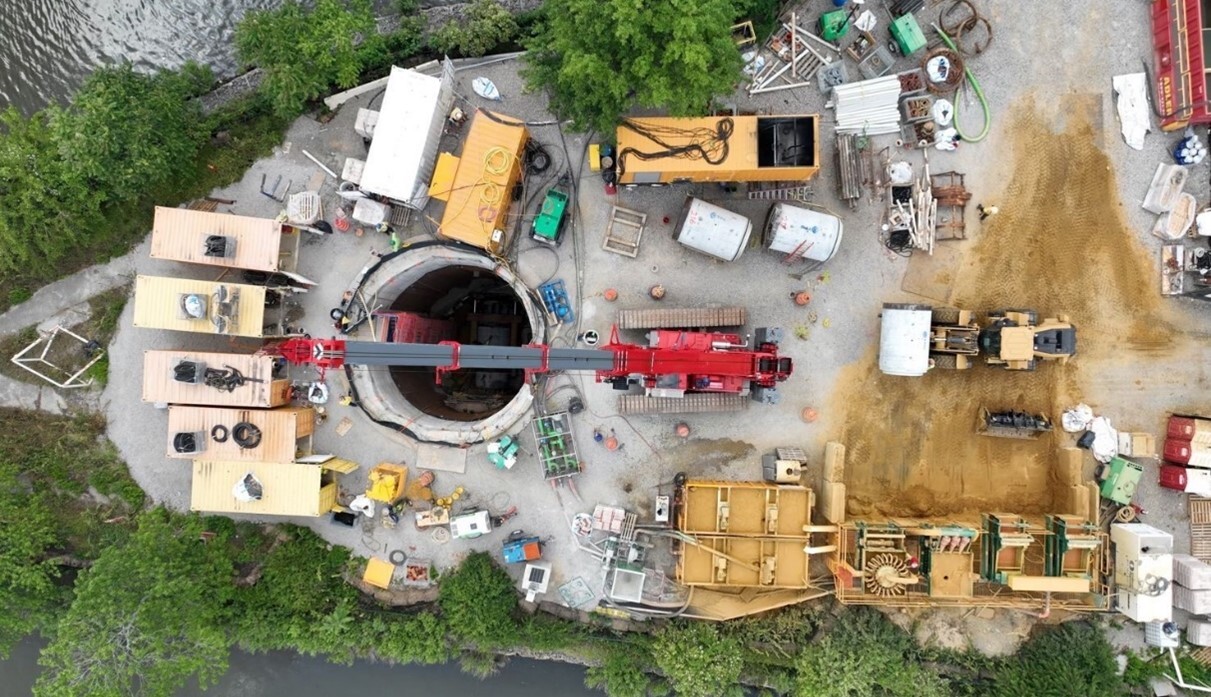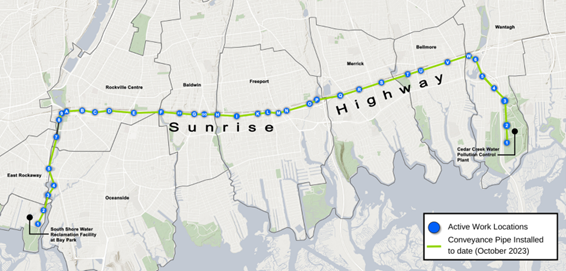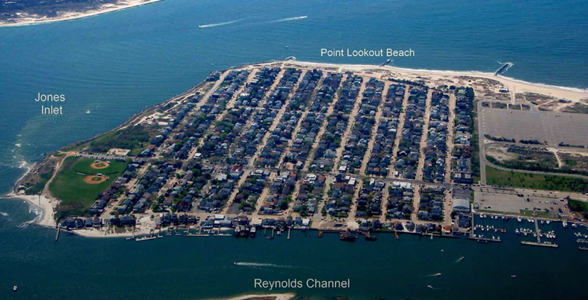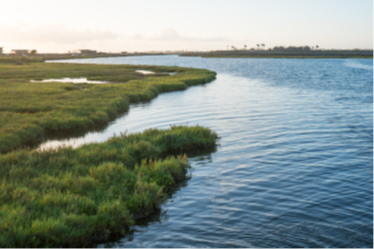Long Island Nitrogen Action Plan (LINAP)- Newsletter
The New York State Department of Environmental Conservation sent this bulletin on 11/13/2023 09:00 AM EST |
| DEC Delivers - Information to keep you connected and informed from the NYS Department of Environmental Conservation |
Long Island Nitrogen Action Plan (LINAP) - Newsletter
|
|
For decades, the Western Bays of Long Island have been polluted by effluent from wastewater treatment plants such as the South Shore Water Reclamation Facility (SSWRF). To address this, Nassau County, New York State, and local municipalities have partnered to remove the discharge from the SSWRF and other wastewater treatment plants from Reynold’s Channel and the surrounding area. Readers of this newsletter may recall in-depth articles on this topic in the October and November 2022 LINAP newsletter. This month’s newsletter includes an update on the project to move the wastewater from the SSWRF to the Cedar Creek Water Pollution Control Plan, as well as updates on multiple projects aimed at reducing nitrogen pollution throughout Nassau County. Bay Park Conveyance Project The Bay Park Conveyance Project, a collaborative effort between the New York State Department of Environmental Conservation (NYSDEC) and Nassau County Department of Public Works, has been making significant progress this past year. This groundbreaking project will convey treated wastewater 10.9 miles from the South Shore Water Reclamation Facility (SSWRF), which currently discharges into Reynolds Channel, to the Cedar Creek Water Pollution Control Plant (WPCP) ocean outfall pipe. The ocean outfall is approximately three miles offshore in the Atlantic Ocean. The Project employs innovative trenchless techniques- microtunneling and sliplining- to install new pipes deep below the ground, minimizing surface disturbance. The microtunneling project is divided into two segments: one extends two miles from the SSWRF north to Sunrise Highway in Rockville Centre, while the other segment covers 1.6 miles from Sunrise Highway in Wantagh to the Cedar Creek WPCP. The two segments are connected by 7.3 miles of an existing abandoned aqueduct beneath Sunrise Highway that was repurposed for this project.
Microtunneling technique used to install piping deep into the ground. Photo credit: DEC To date, over 75 percent of the construction is complete, and the project is on track for its anticipated completion in June 2024 with a six-month testing/commissioning period to follow before full function. This project's significance cannot be overstated, as it is set to divert 75 million gallons per day (MGD) of treated wastewater, reducing nitrogen loading in Reynolds Channel and the Western Bays by up to 90 percent! The results of the project will spur the ecological recovery of the Western Bays marshlands, which will protect coastal communities from storm surge and sea-level rise. The improved water quality will enhance and expand water-based recreational and commercial opportunities.
Bay Park Conveyance Project Active Work Locations. Photo Credit: DEC For more in-depth information about the Bay Park Conveyance Project, including interactive resources and project timelines, please visit the Bay Park Conveyance Project's website. Long Beach Water Pollution Control Plant Consolidation Project The project to convert the Long Beach Water Pollution Control Plant (WPCP) to a pump station and reroute Long Beach’s wastewater – with an average flow of 5 MGD and current peak flow of about 16 MGD – to the newly upgraded SSWRF is underway. The wastewater will be treated more effectively at SSWRF before being sent to Cedar Creek Wastewater WPCP and discharged into the ocean. The project is based on an intermunicipal agreement between Nassau County and the City of Long Beach. The County has hired a consultant to construct the project, and it is expected to be completed in 2025. Point Lookout Sewer Study Point Lookout, a hamlet surrounded on three sides, is one of the few areas on Nassau County’s south shore that remains unsewered and relies on outdated cesspools and septic systems. In 2018, the Nassau County legislature approved $1 million for a sewering feasibility study in Point Lookout. Based on the study results, the County received $2 million from the Long Island Regional Economic Development Award to plan, design, and construct sewer infrastructure for the over 800 homes and businesses in Point Lookout. The County has hired a consulting firm to complete the feasibility study. The study is the first step in ushering in a new era of public wastewater treatment in Point Lookout. Once installed, the benefits to the area’s environment and economy will be remarkable.
Photo Credit: Point Lookout Historical Society. South Shore Water Reclamation Facility (SSWRF) Nitrogen Removal Nassau County has undertaken a significant environmental initiative with two critical projects aimed at mitigating nitrogen pollution in wastewater effluent released from the SSWRF. The first of these initiatives is Biological Nutrient Removal (BNR). In 2022, BNR successfully completed its performance evaluation phase. Since the implementation of BNR, the average nitrogen load went from 15,000 lbs/day to 11,534 lbs/day. The second project, Sidestream Centrate Treatment process, is poised to initiate full-scale implementation starting in December 2023 and is expected to bring the nitrogen load down to 8,700 lbs/day. Once the Bay Park Conveyance Project is operational the projected average is expected to go down to 1,650 lbs/day! The implementation of these projects will lead to an unprecedented reduction in nitrogen pollution resulting from Nassau County’s largest wastewater treatment plant.
Photo Credit: LIRPC Septic Environmental Program to Improve Cleanliness (S.E.P.T.I.C.) Tens of thousands of homes and some small businesses on the north shore of Nassau County rely on cesspools and septic systems to treat their household wastewater. Often these systems are inadequate, and this impacts the area’s water. The County and State urge property owners in these areas to upgrade to innovative alternative septic systems that remove most of the nitrogen. The Nassau County Septic Environmental Program to Improve Cleanliness S.E.P.T.I.C is a grant program for homeowners and owners of small business that provides funds towards upgrading their septic systems. The program is run by the Nassau County Soil and Water Conservation District and offers grants of up to $20,000 to replace failing septic systems with nitrogen-reducing Innovative and Alternative Onsite Wastewater Treatment Systems (I/A OWTS). To date, over 275 residents have applied to the program, contributing to the effort to improve water quality in Nassau County. For more information and instructions on how to apply, please contact SepticReplace@nassaucountyny.gov or call 516-364-5861. Online applications can be submitted on the SEPTIC webpage. Grant Opportunity- Long Island Community Impact Fund (LISCIF) The Long Island Sound Community Impact Fund (LISCIF) is accepting Letters of Intent. The purpose of LISCIF is to provide technical and financial assistance to environmental justice communities to address environmental issues and improve the quality and accessibility of the Long Island Sound. The first round of LISCIF will award up to $1,500,000 in competitive funding to projects in the Long Island Sound watershed in New York and Connecticut. The outcomes of project proposals must meet Implementation Actions of the Long Island Sound Comprehensive Conservation and Management Plan (CCMP). For 2024, LISCIF’s main funding themes are:
Funding is available for:
Letters of Intent (LOIs) are due December 1, 2023, 4:00 pm EST. Visit the LISCIF webpage for more information. You can also schedule a 1-on-1 meeting with Shahela Begum, Program Director for the LISCIF, to discuss your application through this link: https://calendly.com/liscif/shahela. The Long Island Sound Community Impact Fund (LISCIF) is a partnership between Restore America’s Estuaries, the U.S. Environmental Protection Agency, and the Long Island Sound Study (LISS). To sign up for the LINAP newsletter, visit our webpage or click here. |




